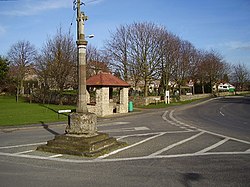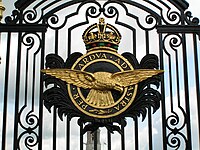Cranwell
| Cranwell | |
| Lincolnshire | |
|---|---|
 Cranwell village centre | |
| Location | |
| Grid reference: | TF034502 |
| Location: | 53°2’12"N, 0°27’43"W |
| Data | |
| Population: | 2,827 (2011) |
| Post town: | Sleaford |
| Postcode: | NG34 |
| Dialling code: | 01400 |
| Local Government | |
| Council: | North Kesteven |
| Parliamentary constituency: |
Sleaford and North Hykeham |
Cranwell is a village in Kesteven, the south-western part of Lincolnshire, about thre miles north-west of Sleaford and fourteen miles south-east of the county town, the City of Lincoln.
The principal through road, the B1429 between the A15 to the east and the A17 to the west, joins the village to RAF Cranwell.
The name Cranwell is thought to mean 'Crane well', which is to say a spring or stream frequented by cranes or herons.
History
The village centres on the remains of the village cross. The cross is a 14th-century market cross (or buttercross) from which important matters of public moment were announced. The cross, which is listed as a scheduled monument, had restoration work carried out by a Mr CH Fowler between 1903 and 1904.[1]
Cranwell manor was held by the Thorold family from the 16th century for over three hundred years. The manor house was demolished in 1816 and the Hall Farm's farmhouse was erected on the site. The Thorold family moved to a new mansion at Syston Park. In 1871 Sir John Thorold is recorded as owning all the land in Cranwell with the exception of the church glebelands and a single farmstead that was under the ownership of St John's College, Cambridge.[2]
In 1682, Sir William and his wife Lady Anne Thorold are recorded as establishing a charity that gave about £8 and 2 shillings a year for the poor, to be distributed on Lady Day (25 March; then considered to be New Year's Day). The parish also benefited from the will of Lady Margaret Thorold who granted £15 a year to apprentice four boys from the village. With the Poor Law Amendment Act reforms of 1834, the parish became part of the Sleaford Poor Law Union group of parishes.
The population of the village in 1801 was recorded as being just 88 people and even by 1911 had only risen to 184. The village only grew and has continued to expand since the opening of the aviation training facility and now stands in the region of 3,000 residents.
Cranwell railway station, on a single track branch line from Sleaford, opened in 1917 and served the naval aviation training facility then known as RNAS Daedalus, later to become RAF Cranwell. The branch line was closed in 1956 and the track removed. However, the original station building still stands and is in use as the current RAF main guardroom. Engine sheds in a small goods yard area closer to the village were demolished and the land re-used for housing.
Parish church
Standing near to the cross is the village's parish church, St Andrew. The church originates around the 10th century, the village possibly dates from the time of King Alfred (849-899). The church consists only of a nave and chancel with, above the former, a bellcote. Much of the masonry is Norman]] but parts date back to Anglo-Saxon times. The fittings include 17th century bench-ends and a Perpendicular Gothic rood screen.
Mounted on corbels in the north aisle are the remains of a hogsback grave. The carvings on these stones are either Saxon or Norse (Ringerike). The stones are unique to Lincolnshire and are probably the finest of their type in the country. In the stonework in the porch is the incised outline of a pilgrim's shoe and the year 1728, and on the right-hand door pillar are six carved figures believed to depict ancient May King and Queen ceremonial costumes.
The churchyard includes a Commonwealth War Graves Commission cemetery with 131 graves from First and Second World Wars.
RAF College Cranwell
Just over one mile to the west of the village is the Royal Air Force College Cranwell, within RAF Cranwell, with its two associated airfields. The northern airfield is the older, being used for light aircraft and airships from 1916 and remains as a grassed field used regularly by gliders]] and light aircraft. The southern airfield is much larger with two paved runways and abuts the A17 road, this was first used as a flying training base in 1917. The paved runways were built in 1954, to make way for the jet aircraft, Meteor and Vampire.
Cranwell does not have a public house. It does, however, have a members only social club. This dates back to when the cadets training at RAF Cranwell during the Second World War used to come into the village to try and buy alcohol. The members only club was introduced as a deterrent to them, being only temporary residents in the area they were therefore unable to gain membership. To this day, no pub has ever opened its doors to the public, even though the reasons for not having one have long since become obsolete.[3]
Outside links
| ("Wikimedia Commons" has material about Cranwell) |
References
- ↑ National Heritage List 1254082: Village Cross (Grade II listing)
- ↑ Information on Cranwell from GENUKI: See Thorold Family
- ↑ Cranwell, Brauncewell & Byards Leap Cranwell, Brauncewell and Byards Leap Parish Council
